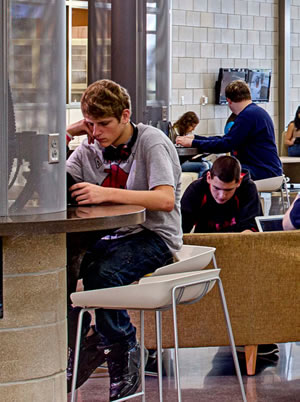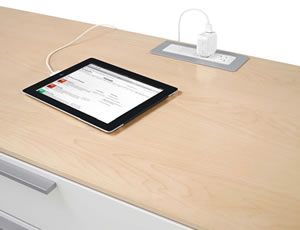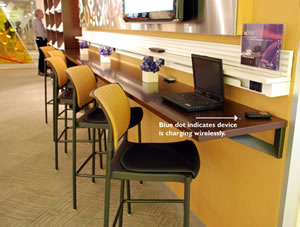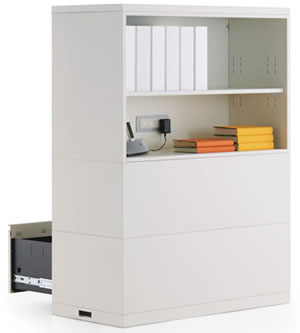Powering Up Learning
Make integrated power a part of your educational delivery strategy.

PHOTO COURTESY OF FANNING HOWEY/ PHOTOGRAPHER: JUSTIN MACONOCHIE.
In many schools today, the first question asked by students and teachers is, “Where do I plug in?” The issue of power and data delivery is a significant one in 21st century schools, especially at high schools and institutions of higher learning. Once laptops and hand-held devices are in the hands of students and teachers, how do you provide a readily available power supply in an efficient and effective way?
Accessible Power
Many educational communities are increasingly turning to the next generation of school furniture and equipment to address this challenge. Just as traditional white boards are now technologically enabled, so too are tables, chairs, podiums and shelving. Increasingly, these products are being offered with integrated charging and data capabilities. This strategy makes a great deal of sense for schools focused on delivering project-based learning or 1:1 learning programs.
A NEW KIND OF FLEXIBLE
Integrated power and data is delivered through a variety of ways in furniture and equipment. Desks and chairs are equipped with outlets and data plugs, either on top of the work surface or recessed into the base of the product. Some newer models even offer wireless charging. In this approach, the student or teacher simply places their mobile device on the work surface. Charging begins instantly, thanks to inductive coils found in the table or chair, as well as in the device itself.
Power-enabled furniture and equipment has several benefits when compared to traditional modes of power and data delivery. Many 21st century learning environments use in-floor outlets to distribute power and data throughout largest collaboration spaces. However, this approach greatly restricts the ebb and flow of activity that is desired in 21st century schools. It is very difficult to anticipate all potential outcomes when designing schools with in-floor outlets. Installation issues are also frequently common. It is much easier to replace a wall-mounted beltline charging counter than it is to remove an in-floor outlet encased in concrete.

PHOTO COURTESY OF HERMAN MILLER
Raised access floors are another common strategy. These systems include two levels of flooring. The sub-floor is accessed through a series of panels, allowing power and data wiring to be reconfigured at will. The major drawback to this approach is that raised access floor systems are often prohibitively expensive. Power- and data-enabled furniture provides a similar level of flexibility at a significantly reduced cost.
CREATING GATHERING SPACES
The key to effectively integrating power and data within furniture and equipment is to try to create a series of gathering spaces within the overall educational facility. In a research commons or a large extended learning area, it is best to keep data and power limited to the periphery of the space. This leaves the center open for large group collaboration and allows furniture and equipment to be easily reconfigured. Power- and data-enabled tables and chairs are best arranged along the walls, where wiring is easily provided. Such an arrangement creates a series of hubs or “landing areas” for students.
For example, teaming tables are one of the most popular spaces within a middle school and high school environment. These tables include an integrated video monitor, or a pair of monitors. Students and teachers connect to the monitor through a central data port. Using a puck system, they share control of the video screen, allowing team members to display and share information quickly and seamlessly.
Counter with Wireless Charging

PHOTO COURTESY OF KI
Products such as teaming tables are best used to create central meeting areas. For more informal interaction, power-enabled chairs provide a place to study in small groups or individually. Often, such tables are arranged in pairs, providing the ideal destination for a spontaneous conversation, or a quiet space for self-directed learning. The strategic placement of these gathering spaces creates a multifaceted learning environment. Careful consideration should be given to the arrangement of team tables and power-enabled chairs, as these products will be somewhat fixed, due to their need for a nearby outlet.
POWERING UP THE CLASSROOM
Middle, high school and higher education classrooms require a different approach to furniture and equipment. Because classrooms are typically much smaller than large collaboration areas, the power and data requirements are very different. Rather than power-enabled tables and chairs, classrooms are best served by charging counters with beltline access. Charging counters, which are typically placed at a height of 36 to 40 inches off the floor, are much more accessible than the traditional power outlet. These counters are ideal for longer-term charging, as students focus on group discussion or engage in lecture-style activities in the classroom.
Power-enabled instructor podiums are another important part of the classroom. From a podium, teachers are able to control multiple display devices within the room. In a LearnLab-type environment, this is especially important. A power-enabled podium will support any mobile device or laptop and will also typically include control of the classroom’s audio enhancement system.
A TAPESTRY OF OPTIONS
There are many ways to deliver power and data access. While tables and chairs are popular methods, there are several other creative options available. For example, at the Milan Center for Innovative Studies in Milan, Mich., power and data access is provided at structural columns within the school’s central Innovation Zone. Each column is wrapped in a wire mesh that houses power and data wiring for laptops and mobile devices. A 42-inch-high countertop and high top-style seating creates the perfect area for individual study.
For long-term charging, traditional products may be more appropriate. At Milan, students load their laptops and tablets into a mobile charging cart at the end of the day. The cart is then stored securely in the school’s technology closet for overnight storage.
As within any holistic strategy, the key to power-enabled furniture and equipment is to look at all the options and make the best choices for your educational community.
THE POWER OF COLLABORATION
Furniture and equipment has long been the domain of interior designers. However, to effectively incorporate modern, powerenabled products, you need to involve multiple stakeholders in the conversation. Administrators, instructors and information technology staff are key contributors. From the design team, it is important to include electrical engineers and technology designers, as well as interior designers.
Another key member of the team is the manufacturer. The trend toward powerenabled furniture and equipment is a fairly new development in the K-12 school community. As a result, it is important to carefully consider all options. You must make sure that your design team is in close communication with the manufacturer’s representative. Power-enabled furniture and equipment must accommodate a broad range of products and devices. Compatibility with current charging devices, as well as those anticipated in the future, is obviously a key consideration.
Involving the manufacturer early on in the process is often the key to a holistic, streamlined solution. Whenever possible, it is best to address issues of power and data delivery as part of the overall furniture and equipment package. There are many after-market products available; however, the integration of furniture, equipment and technology is better accomplished through a pre-packaged solution.

PHOTO COURTESY OF HERMAN MILLER
In addition, your design team and the manufacturer’s representative will be able to help you make the most of your budget. Power-enabled chairs are approximately 15 percent more expensive than comparable chairs without charging or data capabilities. For some of the larger teaming tables, the cost may be twice as much as a traditional table. The important thing to remember is that these costs are not just additions to the overall scope. The more money you spend on powerenabled furniture and equipment, the less you will spend on traditional methods of charging and data delivery. However, it is important to discuss exactly what these costs will be and to understand where you are investing your money, and why.
STUDENT-CENTERED SOLUTIONS
Ultimately, the reason for considering power-enable furniture and equipment is a simple one. These products allow students and teachers to use their hand-held and mobile devices to the greatest possible advantage. By answering the question, “Where do I plug in?” you allow students to shift their focus to the actual experience of learning. After all, education should be about the search for knowledge, not the search for an outlet and an extension cord.
This article originally appeared in the School Planning & Management October 2013 issue of Spaces4Learning.